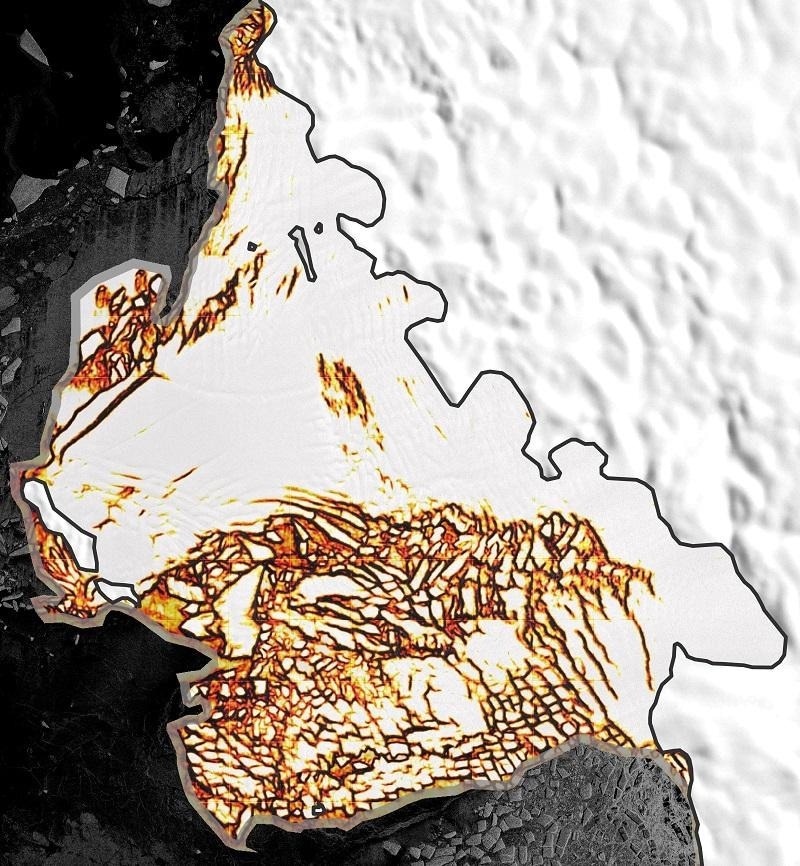A new model AI has been developed by researchers to track the development of crevasses or fractures on the Thwaites Glacier ice tongue situated in west Antarctica.

Scientists have mapped the crevasses on the Thwaites Glacier ice tongue through time using deep learning technology. Image Credit: Trystan Surawy-Stepney
Crevasses are indicators of stress building up in a glacier.
A research group from the University of Leeds and the University of Bristol have altered an AI algorithm that was originally developed to determine cells in microscope images to spot crevasses developing in the ice obtained from satellite images.
Thwaites is a significant part of the Antarctic Ice Sheet and holds sufficient ice to increase global sea levels by nearly 60 cm. Many consider this to be at risk of rapid retreat, thereby causing a threat to coastal communities globally.
Making use of AI will enable researchers to track and model changes more precisely in this significant glacier.
Having been reported in the journal Nature Geoscience, the study centered on a part of the glacier system where the ice flows into the sea and then begins to float. The place where this occurs is called the grounding line, and it develops the start of the Thwaites Eastern ice shelf and the Thwaites Glacier ice tongue, which is also known as an ice shelf.
In spite of being small compared to the size of the full glacier, alterations to such ice shelves could have wide-ranging effects on the complete glacier system and future sea-level increases.
The researchers wished to know if the fracture or crevassing formation was more likely to happen with alterations to the speed of the ice flow.
Developing the Algorithm
With the help of machine learning, the scientists taught a computer to look at radar satellite images and identify changes over the last decade. The images were taken by the European Space Agency’s Sentinel-1 satellites, which have the potential to “see” through the top layer of snow and onto the glacier. This shows the fractured surface of the ice that is normally hidden from sight.
The study discovered a complicated interplay happening between crevasse formation and ice flow speed. When the ice flow slows or quickens, more crevasses are likely to form. As a consequence, the increase in crevasses makes the ice speed change as the level of friction between the ice and essential rock is altered.
Dynamic changes on ice shelves are traditionally thought to occur on timescales of decades to centuries, so it was surprising to see this huge glacier speed up and slow down so quickly.
Dr. Anna Hogg, Author and Glaciologist, Satellite Ice Dynamics Group, University of Leeds
Hogg added, “The study also demonstrates the key role that fractures play in un-corking the flow of ice - a process known as unbuttressing. Ice sheet models must be evolved to account for the fact that ice can fracture, which will allow us to measure future sea level contributions more accurately.”
Trystan Surawy-Stepney, the lead author of the paper and a doctoral researcher at Leeds, added: “The nice thing about this study is the precision with which the crevasses were mapped.”
“It has been known for a while that crevassing is an important component of ice shelf dynamics and this study demonstrates that this link can be studied on a large scale with beautiful resolution, using computer vision techniques applied to the deluge of satellite images acquired each week.”
New data has been offered to the researchers by the satellites orbiting the Earth over Antarctica’s most remote and inaccessible regions. The radar on board named Sentinel-1 enables places like Thwaites Glacier to be pictured day or night, every week, throughout the year.
Studies like this would not be possible without the large volume of high-resolution data provided by Sentinel-1. By continuing to plan future missions, we can carry on supporting work like this and broaden the scope of scientific research on vital areas of the Earth’s climate system.
Dr. Mark Drinkwater, European Space Agency
As for the Thwaites Glacier ice tongue, it remains to be noted if such short-term changes have any effect on the long-lasting dynamics of the glacier, or if they are just isolated symptoms of an ice shelf about to kick off.
The study was authored by Trystan Surawy-Stepney, Anna E. Hogg and Benjamin J. Davison, from the University of Leeds; and Stephen L. Cornford, from the University of Bristol.
Journal Reference
Surawy-Stepney, T., et al. (2022) Episodic dynamic change linked to damage on the thwaites glacier ice tongue. Nature Geoscience. doi.org/10.1038/s41561-022-01097-9.